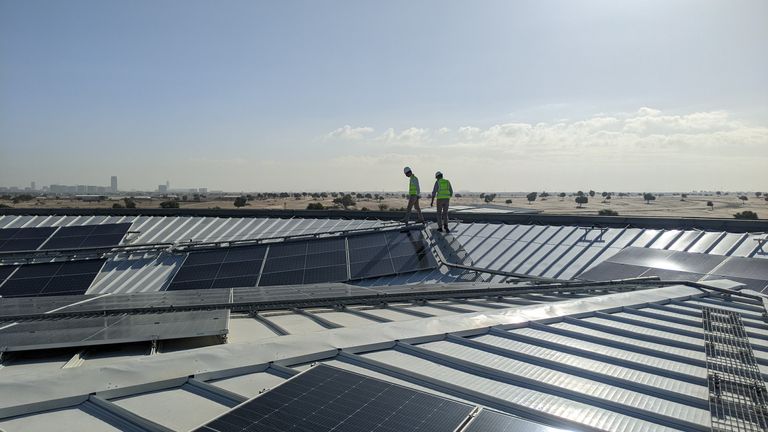Green desert.
To my left, the waves of sand are broken by sparse scrubby trees.
To my right, the towering skyscrapers of Dubai.
But beneath my feet, a solar power station on top of a school.
The petrostate is changing.
Kings’ School Al Barsha provides some evidence, where 3,000 pupils study here beneath two megawatts of solar panels.
Solar is a perfect fit here, not just because the sun shines almost every day, but also nearly three-quarters of electricity in the Emirates is used to run air conditioning – vital on sunny days.
These panels were installed by SirajPower – and its CEO, Laurent Longuet, used to work for the oil company Total.
“Ten years ago, I had a lot of friends working in nuclear or conventional fuels, they were making fun of solar but now a lot of them work in solar,” he said.
“Over a full year, more than half of the energy is coming from the roof, but on certain days we export some electricity back to the network. Solar is by far the cheapest form of electricity. Even here, it’s 50% less [than fossil fuels].”
With solar so cheap, the business case for it and the climate case are aligned, which may be a bigger driver than altruism. Though solar rooftops are still the exception, they are spreading – as are giant solar farms in the desert.
Dubai now gets 15% of its energy from renewables. The greener shift isn’t just in solar power but in a less obvious desert winner: growing salad vegetables.
Towards the Omani border lies al Ain, a city founded on an oasis with a history of farming.
But now it’s gone very hi-tech.
Narrow trays of growing spinach move imperceptibly slowly through a giant glass house cooled by evaporation from the plants with a little extra help on the hottest days. Planting, movement, nutrition and harvest are all robotic.
The head grower of Pure Harvest farms, Jan Prins, has grown veg all over the world.
“This is the most sophisticated greenhouse I have ever worked in,” he said. “We have such control here – despite the harsh environment, we can create conditions where the plant will flourish and there is the optimum transfer of sunlight into food.”
They produce 15 tonnes of spinach here every week and 25 tonnes of peppers alongside melons, strawberries, blackberries and tomatoes.
Some veg is still rooted in peat, which has climate impacts as it emits carbon dioxide when it dries, but Jan is convinced this is outweighed by the benefit of being local.
“You don’t want to put your tomatoes in an aeroplane to fly them from Europe to here, so from that perspective for the planet this is a better solution.”
But the Emirates, like many wealthy nations, wastes huge amounts of food – much of which goes to landfill to rot and emit methane, a powerful greenhouse gas.
Companies are starting to fill the green void here, too.
Aliyu Mohammed Ali is the co-founder of Efhaaz – and as I walk through their yard, they are recycling fresh food, coffee cups, hand lotion, sacks of rice, plastic pot scourers and even aircraft seats to make compost, car cleaners, worktops and more.
“There is over $1.6bn (£1.26bn) of food that is wasted annually from the Emirates – around 200kg per person,” he said. We are growing five to seven times our capacity every year. We are trying to be a force for good for the environment while at the same time being a force for business growth and profits.”
All these companies feel real change happening – the Emirates going from laggards to major players in green tech.
But the country is still making billions extracting and exporting fossil fuels, with plans to pump much more.
At least now it’s no longer the only game in town.
